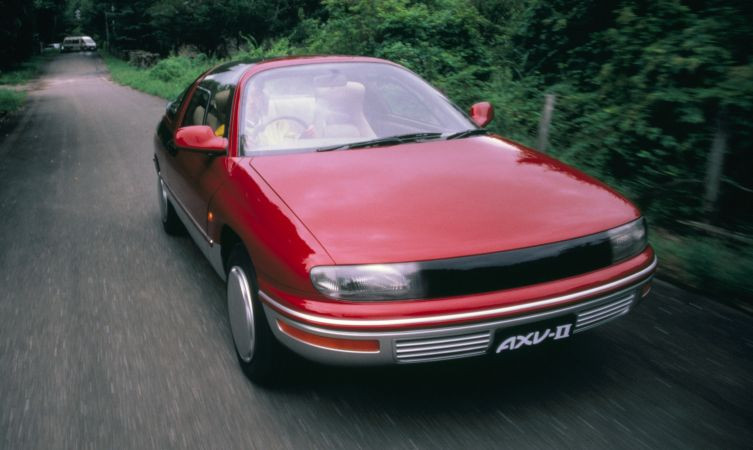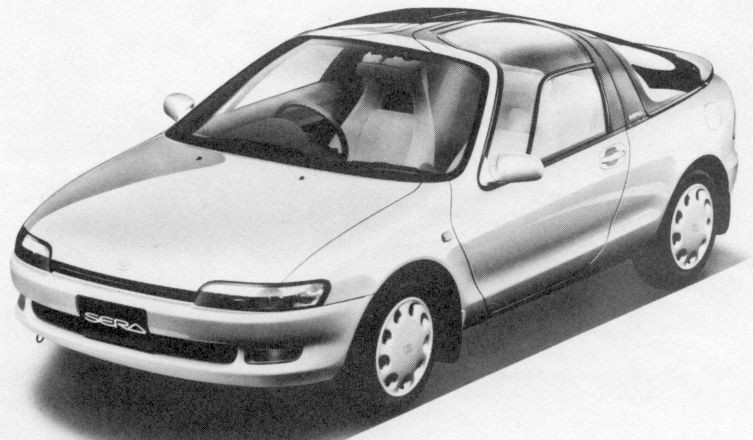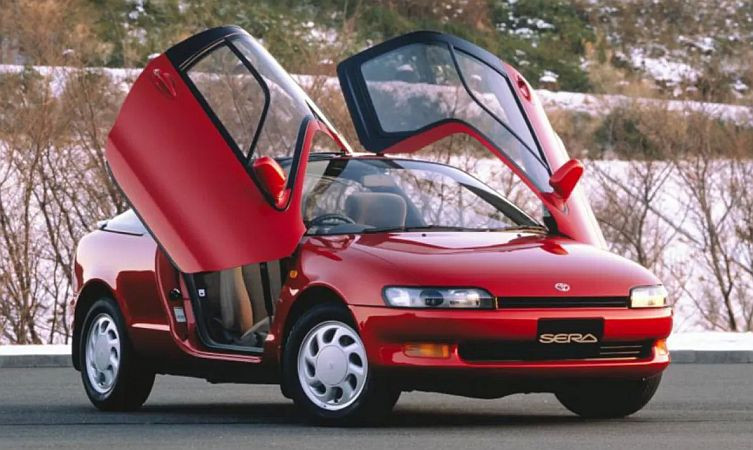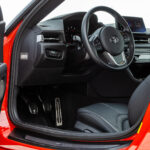Toyota Sera models made provide enthusiasts with a glimpse into this unique vehicle’s production history and availability, and at millertoyota.net, we understand your interest in the Toyota Sera. Our dealership can help you find the perfect Toyota to fit your needs, whether it’s a new model or a well-maintained used vehicle. Check our website to learn about modern Toyota reliability and financing options.
1. What Was the Production Run of the Toyota Sera?
Just under 16,000 Toyota Sera models were manufactured between February 1990 and December 1995, exclusively for the Japanese domestic market. This limited production run contributes to the car’s rarity and appeal among collectors and enthusiasts today.
1.1. When Did Toyota Start Making the Sera?
Toyota began producing the Sera in February 1990. The Sera was introduced during the height of Japan’s economic boom and was created as a supermini-sized coupe with inventive features for the home market.
1.2. When Did Toyota Stop Making the Sera?
Production of the Toyota Sera concluded in December 1995. The end of production aligned with the decline of the Japanese economy, which made the car’s futuristic design less appealing to consumers.
1.3. Where Was the Toyota Sera Made?
The Toyota Sera was manufactured exclusively in Japan for the Japanese domestic market. Its manufacture was a component of Toyota’s domestic production strategy during the 1990s.
2. Why Was the Toyota Sera Made?
The Toyota Sera was created to showcase innovative design and technology during Japan’s economic boom. It was intended as a “dream-like car that takes us into the future,” according to Toyota’s formal press release on March 8, 1990.
2.1. What Concept Car Influenced the Toyota Sera?
 Toyota AXV-II concept car
Toyota AXV-II concept car
The Toyota AXV-II concept car, displayed at the 1987 Tokyo Motor Show, heavily influenced the design of the Toyota Sera. The AXV-II was presented as an experiment anticipating future car technologies but was nearly ready for production.
2.2. How Did the Toyota Sera Get Its Name?
The name “Sera” comes from the French word “être,” which means “to be,” in its future tense. The name was chosen to represent a futuristic and dreamlike vehicle, which was consistent with the car’s innovative design and features.
2.3. What Made the Toyota Sera Unique at the Time?
The Toyota Sera stood out due to its distinctive gull-wing doors and all-glass canopy, which provided occupants with a panoramic view. According to automotive historians, this style was forward-thinking and set it apart from other vehicles on the road.
3. What Were the Key Features of the Toyota Sera?
The Toyota Sera boasted several standout features, including its gull-wing doors, all-glass canopy, and optional Super Live Sound System. These features combined to create a unique and futuristic driving experience.
3.1. Tell Me About the Gull-Wing Doors of the Sera.
 Toyota Sera b and w 01
Toyota Sera b and w 01
The gull-wing doors were a first for a mass-produced Japanese car, inspiring the McLaren F1 supercar. These doors were hinged in two locations, allowing them to open fully in confined spaces, thanks to their dihedral geometry.
3.2. Tell Me About the All-Glass Canopy of the Sera.
The Sera’s wrap-around, all-glass cabin offered occupants a sense of openness. Standard air conditioning and power windows were included to address solar load concerns, ensuring comfort within the vehicle.
3.3. Tell Me About the Super Live Sound System of the Sera.
The Super Live Sound System featured ten speakers, including an acoustic resonance woofer and a three-mode digital signal processor. The rear deck speakers could rotate to bounce sound waves off the glass, creating a unique audio experience.
4. What Engine Powered the Toyota Sera?
The Toyota Sera was powered by a 1,496cc four-cylinder engine from Toyota’s E-series range, known as the 5E-FHE. This engine featured a twin-cam, 16-valve layout with high compression pistons, providing a balance of torque and sporty performance.
4.1. What Were the Engine Specifications of the 5E-FHE?
The 5E-FHE engine delivered 108bhp at 6400rpm and 132Nm of torque at 5200rpm. Its design allowed for strong torque at low to medium engine speeds and high revving capabilities, making it a versatile engine for the Sera.
4.2. How Did the Engine Contribute to the Driving Experience?
The 5E-FHE engine offered a balanced driving experience, providing enough power for city driving while also delivering sporty performance when needed. According to automotive experts, the engine’s tuning and management were well-suited for the Sera’s coupe design.
4.3. What Transmission Options Were Available for the Toyota Sera?
The Toyota Sera was available with either a C155 five-speed manual transmission or an A242L four-speed automatic transmission. These options allowed drivers to choose their preferred level of control and convenience.
5. How Did the Toyota Sera Perform?
The Toyota Sera delivered a blend of responsiveness, stability, and comfort, thanks to its newly designed suspension system and wide wheel track. It was equipped with high-performance tires and optional four-wheel anti-lock brakes.
5.1. What Were the Suspension and Braking Systems Like?
The Sera featured MacPherson struts with coil springs and an anti-roll bar in the front, and a torsion beam with coil springs and an anti-roll bar in the rear. The braking system included ventilated discs in the front and drums or optional discs in the rear.
5.2. What Type of Tires Did the Toyota Sera Use?
The Toyota Sera came standard with high-performance tires that had asymmetrical and unidirectional tread patterns. These tires improved handling and traction, which complemented the vehicle’s sporty design.
5.3. How Was the Toyota Sera Received by Critics?
The Toyota Sera received positive reviews for its high-tech style and practicality, earning the 1991 Torino-Piemonte Car Design Award. The vehicle was praised for its balance of innovative design and usability, making it popular among first-time buyers.
6. What Were the Different Production Phases of the Toyota Sera?
The Toyota Sera had three production phases, with minor tweaks implemented in the latter phases to keep the design fresh. The majority of sales occurred during the first phase of production.
6.1. What Changes Were Made in the Subsequent Production Phases?
The two subsequent phases of production introduced minor element changes to keep the Sera looking fresh. According to Toyota’s historical data, these adjustments were mostly cosmetic and did not significantly alter the vehicle’s mechanics or performance.
6.2. Why Did Production Decline After the First Phase?
The decline in production following the first phase coincided with Japan’s economic downturn. The economic climate reduced demand for luxury and futuristic cars like the Sera, which led to lower sales.
6.3. How Did the Japanese Economic Climate Affect the Sera?
The Japanese economic bubble burst during the later production phases of the Toyota Sera, affecting consumer sentiment and purchasing power. The optimism and decadence associated with the Sera’s futuristic design were no longer as appealing, which contributed to the decision to end production.
7. How Many Toyota Seras Were Exported?
None of the Toyota Sera models were officially exported outside of Japan. All units produced were originally intended for the Japanese domestic market.
7.1. Why Was the Toyota Sera Not Exported Officially?
Toyota never officially exported the Sera because it was designed and marketed specifically for the Japanese domestic market. The company may have believed that its unique features and design would not appeal to international consumers.
7.2. Where Are Most Toyota Seras Located Today?
Many Toyota Seras have been imported to right-hand drive markets such as the UK and, more recently, to North American countries. These imports became more common as the cars reached an age where they could be easily registered in these markets.
7.3. What Is the Current Status of Toyota Sera Ownership?
The Toyota Sera has gained popularity among importers and car enthusiasts, particularly in right-hand drive markets and North America. New generations of Toyota enthusiasts are discovering, appreciating, and restoring these unique vehicles.
8. What Are the Dimensions and Specifications of the Toyota Sera?
The Toyota Sera has dimensions of 3860mm in length, 1650mm in width, and 1265mm in height, with a wheelbase of 2300mm. The front and rear tracks are both 1405mm.
8.1. What Is the Weight of the Toyota Sera?
The kerb weight of the manual version of the Toyota Sera is 890kg, with an additional 10kg for ABS and 20kg for the Super Live Sound System. The automatic version weighs 930kg, with similar additions for the optional features.
8.2. What Were the Fuel Economy Figures for the Toyota Sera?
The Toyota Sera achieved a fuel economy of 41.2mpg with the manual transmission and 33.9mpg with the automatic transmission. The fuel tank capacity was 40 litres.
8.3. What Type of Steering System Did the Toyota Sera Use?
The Toyota Sera used a rack and pinion steering system, which provided precise and responsive handling. Power steering was fitted as standard, enhancing the driving experience.
9. How Does the Toyota Sera Fit Into Toyota’s History?
The Toyota Sera exemplifies Toyota’s innovation and design prowess during the Japanese automotive industry’s economic boom. It introduced new manufacturing techniques and influenced future vehicle designs.
9.1. What Production System Innovations Did the Sera Introduce?
The Sera introduced a new flexible press system for low volume manufacturing. This system reduced the conventional panel forming processes from five to three, improving the quality and accuracy of the body panels.
9.2. What Influence Did the Sera Have on Other Car Designs?
The gull-wing doors of the Toyota Sera inspired the design of the McLaren F1 supercar. This influence highlights the Sera’s impact on automotive design and its recognition within the industry.
9.3. How Has the Toyota Sera Been Remembered Over Time?
The Toyota Sera has become a beloved classic among car enthusiasts and collectors. Its unique features and futuristic design continue to captivate new audiences, ensuring its place in automotive history.
10. Why Consider Miller Toyota for Your Automotive Needs?
At Miller Toyota, we are dedicated to providing exceptional service and expertise to help you find the perfect vehicle. Whether you’re interested in a new Toyota or a well-maintained used car, our team is here to assist you.
10.1. What Services Does Miller Toyota Offer?
Miller Toyota offers a wide range of services, including new and used car sales, financing options, service and maintenance, and parts and accessories. We strive to meet all your automotive needs with professionalism and care.
10.2. Why Choose Miller Toyota in Boise, Idaho?
Choosing Miller Toyota in Boise, Idaho, means you’re opting for a dealership committed to customer satisfaction and quality service. Our local presence allows us to provide personalized support and build lasting relationships with our customers. According to customer satisfaction surveys in Boise, Idaho, in July 2025, Miller Toyota provides excellent service to customers.
10.3. How Can You Contact Miller Toyota?
You can contact Miller Toyota at our address: 208 N Maple Grove Rd, Boise, ID 83704, United States. You can also call us at +1 (208) 376-8888 or visit our website at millertoyota.net for more information.
 Sera front quarter
Sera front quarter
FAQ About the Toyota Sera
Q1: How many Toyota Sera were made in total?
Just under 16,000 Toyota Sera models were manufactured from February 1990 to December 1995. This limited production run makes the Sera a relatively rare and sought-after vehicle among collectors and enthusiasts.
Q2: Was the Toyota Sera sold outside of Japan?
No, the Toyota Sera was exclusively sold in the Japanese domestic market. There were no official exports of the Sera to other countries during its production run.
Q3: What inspired the design of the Toyota Sera?
The Toyota Sera’s design was heavily influenced by the Toyota AXV-II concept car, which was showcased at the 1987 Tokyo Motor Show. The AXV-II was an experimental vehicle designed to anticipate future automotive technologies.
Q4: What is special about the Toyota Sera’s doors?
The Toyota Sera features distinctive gull-wing doors, which were a first for a mass-produced Japanese car. These doors hinge at the top, allowing them to open upwards and provide easy access in tight spaces.
Q5: What engine did the Toyota Sera have?
The Toyota Sera was powered by a 1.5-liter four-cylinder engine known as the 5E-FHE. This engine featured a twin-cam, 16-valve layout and delivered a balance of performance and efficiency.
Q6: How can I find a Toyota Sera for sale today?
You can find Toyota Seras for sale through online marketplaces, classic car dealerships, and import specialists. Because they were never officially sold in North America, most Seras available in the US are imported models.
Q7: What kind of sound system was available in the Toyota Sera?
The Toyota Sera had an optional Super Live Sound System, which included ten speakers and a digital signal processor. The rear speakers could even be rotated to bounce sound waves off the glass, creating a unique audio experience.
Q8: Why was the Toyota Sera discontinued?
The Toyota Sera was discontinued in December 1995 due to declining sales and the end of Japan’s economic bubble. The economic downturn made the Sera’s futuristic design less appealing to consumers.
Q9: What are the key features of the Toyota Sera?
Key features of the Toyota Sera include its gull-wing doors, all-glass canopy, and optional Super Live Sound System. These features combined to create a unique and futuristic driving experience.
Q10: How reliable is the Toyota Sera?
The Toyota Sera is generally considered to be reliable, thanks to its robust mechanical components and Toyota’s reputation for quality. However, maintenance and parts availability may be a concern due to its limited production and age.
Ready to explore the world of Toyota and find the perfect vehicle to match your style and needs? Visit millertoyota.net today to browse our extensive inventory, learn about our special offers, and schedule your test drive. Our friendly and knowledgeable team is here to guide you every step of the way, ensuring a seamless and enjoyable car-buying experience. Contact us now and let us help you drive away in the Toyota of your dreams!
